Human–wildlife conflict
Human–wildlife conflict (HWC) refers to the negative interactions between people and wild animals, with consequences for both people and their resources and wildlife and their habitats (IUCN 2020). HWC, caused by competition for shared natural resources between people and wildlife, influences food security of people and the well-being of both people and animals. In many regions these conflicts have intensified over recent decades as a result of human population growth and the transformation of land use.
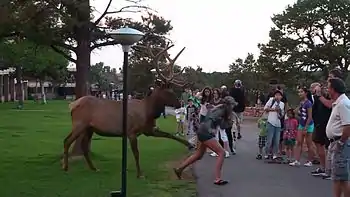
HWC is a serious global threat to sustainable development, food security and conservation in urban and rural landscapes alike. In general, the consequences of HWC include: destruction of crops, reduced farm productivity, competition for grazing lands and water, livestock predation, injury and death to farmers, damage to infrastructure, and increased risk of disease transmission among wildlife and livestock.[2]
With specific reference to forests, a high density of large ungulates, for example deer, can cause severe damage to the forest and can threaten regeneration by trampling or browsing small trees, rubbing themselves on trees or stripping tree bark. This behaviour can have important economic implications and can lead to polarization between forest and wildlife managers (CPW, 2016).[3]
Previously, conflict mitigation strategies utilized lethal control, translocation, population size regulation, and endangered species preservation. Recent management now uses an interdisciplinary set of approaches to solving conflicts. These include applying scientific research, sociological studies, and the arts to reducing conflicts. As human-wildlife conflict inflicts direct and indirect consequences on people and animals, its mitigation is an important priority for the management of biodiversity and protected areas. Resolving human-wildlife conflicts and fostering coexistence requires well-informed, holistic, and collaborative processes that take into account underlying social, cultural and economic contexts.[4]
Many countries are starting to explicitly include human-wildlife conflict in national policies and strategies for wildlife management, development and poverty alleviation. At the national level, cross-sectoral collaboration between forestry, wildlife, agriculture, livestock and other relevant sectors is key.[3]
Meaning
Human–wildlife conflict is defined by the World Wide Fund for Nature (WWF) as "any interaction between humans and wildlife that results in negative impacts of human social, economic or cultural life, on the conservation of wildlife populations, or on the environment.[5] The Creating Co-existence workshop at the 5th Annual World Parks Congress (8–17 September 2003, Montreal) defined human-wildlife conflict in the context of human goals and animal needs as follows: “Human-wildlife conflict occurs when the needs and behavior of wildlife impact negatively on the goals of humans or when the goals of humans negatively impact the needs of wildlife."[6]
A 2007 review by the United States Geological Survey defines human-wildlife conflict in two contexts; firstly, actions by wildlife conflict with human goals i.e. life, livelihood and life-style, and secondly, human activities that threaten the safety and survival of wildlife. However, in both cases outcomes are decided by human responses to the interactions.[7]
The Government of Yukon defines human-wildlife conflict simply, but through the lens of damage to property, i.e. "any interaction between wildlife and humans which causes harm, whether it’s to the human, the wild animal, or property."[8] Here, property includes buildings, equipment and camps, livestock and pets, but does not include crops, fields or fences.
The IUCN SSC Human-Wildlife Conflict Task Force describes human-wildlife conflict as struggles that emerge when the presence or behaviour of wildlife poses actual or perceived, direct and recurring threat to human interests or needs, leading to disagreements between groups of people and negative impacts on people and/or wildlife.[9]
History
Human-wildlife interactions have occurred throughout man's prehistory and recorded history. Among the early forms of human-wildlife conflict is the depredation of the ancestors of prehistoric man by a number of predators of the Miocene such as saber-toothed cats, leopards, and spotted hyenas.[10]
Fossil remains of early hominids show evidence of depredation; the Taung Child, the fossilized skull of a young Australopithecus africanus, is thought to have been killed by an eagle from the distinct marks on its skull and the fossil having been found among egg shells and remains of small animals.[11]
A Plio-Pleistocene horned crocodile, Crocodylus anthropophagus, whose fossil remains have been recorded from Olduvai Gorge, was the largest predator encountered by prehistoric man, as indicated by hominid specimens preserving crocodile bite marks from these sites.[12]
Examples of Human-Wildlife Conflict
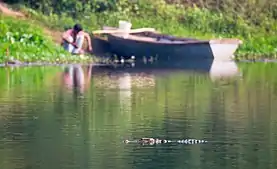
Africa
As a tropical continent with substantial anthropogenic development, the Africa is a hotspot for biodiversity[13] and therefore, for human-wildlife conflict. Two of the primary examples of conflict in Africa are human-predator (lions, leopards, cheetahs, etc.) and human-elephant conflict. Depredation of livestock by African predators is well documented in Kenya,[14] Namibia,[15] Botswana,[16] and more. African elephants frequently clash with humans, as their long-distance migrations often intersect with farms. The resulting damage to crops, infrastructure, and at times, people, can lead to the retaliatory killing of elephants by locals.[17]
In 2017 more than 8 000 human-wildlife conflict incidents were reported in Namibia alone (World Bank, 2019). Hyenas killed more than 600 cattle in the Zambezi Region of Namibia between 2011 and 2016 and there were more than 4 000 incidents of crop damage, mostly caused by elephants moving through the region (NACSO, 2017a).[3]
Asia
With a rapidly increasing human population and high biodiversity,[13] interactions between people and wild animals are becoming more and more prevalent. Like human-predator in Africa, encounters between tigers, people, and their livestock is a prominent issue on the Asian continent. Attacks on humans and livestock have exacerbated major threats the tiger conservation such as mortality, removal of individuals from the wild, and negative perceptions of the animals from locals.[18] Even non-predator conflicts are common, with crop-raiding by elephants[19] and macaques[20] persisting in both rural and urban environments, respectively.
In Sri Lanka, for example, each year as many as 80 people are killed by elephants and more than 230 elephants are killed by farmers. The Sri Lankan elephant is listed as endangered, and only 2 500–4 000 individuals remain in the wild (IIED, 2019).[3]
Antarctica
The first instance of death due to human-wildlife conflict in Antarctica occurred in 2003 when a leopard seal dragged a snorkelling British marine biologist underwater because of which she drowned.[21]
Europe
Human–wildlife conflict in Europe includes interactions between people and both carnivores and herbivores. A variety of non-predators such as deer, wild boar, rodents, and starlings have been shown to damage crops and forests.[22] Carnivores like raptors and bears create conflict with humans by eating both farmed and wild fish,[22] while others like lynxes and wolves prey upon livestock.[23] Even less apparent cases of human-wildlife conflict can cause substantial losses; 500,000 deer-vehicle collisions in Europe (and 1-1.5 million in North America) led to 30,000 injuries and 200 deaths.[24]
North America
Instances of human-wildlife conflict are widespread in North America. In Wisconsin, United States wolf depredation of livestock is a prominent issue that resulted in the injury or death of 377 domestic animals over a 24-year span.[25] Similar incidents were reported in the Greater Yellowstone ecosystem, with reports of wolves killing pets and livestock.[26] Expanding urban centers have created increasing human-wildlife conflicts, with interactions between human and coyotes and mountain lions documented in cities in Colorado and California, respectively, among others.[27][28] Big cats are a similar source of conflict in Central Mexico, where reports of livestock depredation are widespread,[29] while interactions between humans and coyotes were observed in Canadian cities as well.[30]
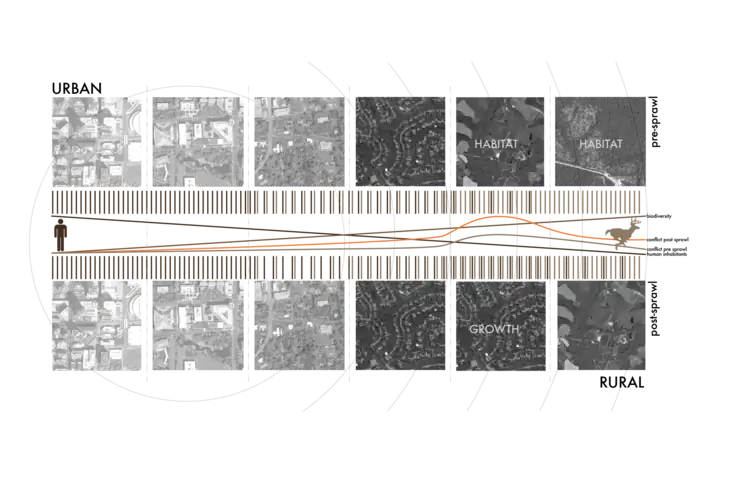
Oceania
On K’gari-Fraser Island in Australia, attacks by wild dingoes on humans (including the death of a child) created a human-wildlife crisis that required scientific intervention to manage.[31] In New Zealand, distrust and dislike of introducing predatory birds (such as the New Zealand Falcon) to vineyard landscapes led to tensions between people and the surrounding wildlife.[32][33] In extreme cases large birds have been reported to attack people who approach their nests, with human-magpie conflict in Australia a well-known example.[34] Even conflict in urban environments has been documented, with development increasing the frequency of human-possum interactions in Sydney.[35]
South America
As with most continents, the depredation of livestock by wild animals is a primary source of human-wildlife conflict in South America. The killings of guanacos by predators in Patagonia, Chile – which possess both economic and cultural value in the region – have created tensions between ranchers and wildlife.[36] South America’s only species of bear, the Andean Bear, faces population declines due to similar conflict with livestock owners in countries like Ecuador.[37]
Marine Ecosystems
Human–wildlife conflict is not limited to terrestrial ecosystems, but is prevalent in the world’s oceans as well. As with terrestrial conflict, human-wildlife conflict in aquatic environments is incredibly diverse and extends across the globe. In Hawaii, for example, an increase in monk seals around the islands has created a conflict between locals who believe that seals “belong” and those who do not.[38] Marine predators such as killer whales[39] and fur seals[40] compete with fisheries for food and resources, while others like great white sharks have a history of injuring humans.[41] While many of the causes of human-wildlife conflict are the same between terrestrial and marine ecosystems (depredation, competition, human injury, etc.), ocean environments are less studied and management approaches often differ.[41]
Mitigation Strategies
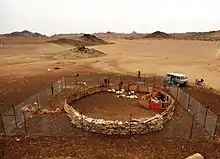
Mitigation strategies for managing human-wildlife conflict vary significantly depending on location and type of conflict. The preference is always for passive, non-intrusive prevention measures but often active intervention is required to be carried out in conjunction.[8] Regardless of approach, the most successful solutions are those that include local communities in the planning, implementation, and maintenance.[42] Resolving conflicts, therefore, often requires a regional plan of attack with a response tailored to the specific crisis.[43] Still, there are a variety of management techniques that are frequently employed to mitigate conflicts. Examples include:
- Translocation of problematic animals: Relocating so-called "problem" animals from a site of conflict to a new place is a mitigation technique used in the past, although recent research has shown that this approach can have detrimental impacts on species and is largely ineffective.[44] Translocation can decrease survival rates and lead to extreme dispersal movements for a species, and often "problem" animals will resume conflict behaviors in their new location.[45]
- Erection of fences or other barriers: Building barriers around cattle bomas,[14] creating distinct wildlife corridors,[46] and erecting beehive fences around farms to deter elephants[47] have all demonstrated the ability to be successful and cost-effective strategies for mitigating human-wildlife conflict.
- Improving community education and perception of animals: Various cultures have myriad views and values associated with the natural world, and how wildlife is perceived can play a role in exacerbating or alleviating human-wildlife conflict. In one Masaai community where young men once obtained status by killing lions, conservationists worked with community leaders to shift perceptions and allow those young men to achieve the same social status by protecting lions instead.[42]
- Effective land use planning: altering land use practices can help mitigate conflict between humans and crop-raiding animals. For example in Mozambique, communities started to grow more chili pepper plants after making the discovery that elephants dislike and avoid plants containing capsaicin. This creative and effective method discourages elephants from trampling community farmers' fields as well as protects the species.[48]
- Compensation: Compensation: in some cases, governmental systems have been established to offer monetary compensation for losses sustained due to human-wildlife conflict. These systems hope to deter the need for retaliatory killings of animals, and to financially incentivize the co-existing of humans and wildlife.[49] Compensation strategies have been employed in India,[50] Italy,[49] and South Africa,[51] to name a few. The success of compensation in managing human-wildlife conflict has varied greatly due to under-compensation, a lack of local participation, or a failure by the government to provide timely payments.[49][50]
- Spatial analyses and mapping conflict hotspots: mapping interactions and creating spatial models has been successful in mitigating human-carnivore conflict[52] and human-elephant conflict,[53] among others. In Kenya, for example, using grid-based geographical information systems in collaboration with simple statistical analyses allowed conservationists to establish an effective predictor for human-elephant conflict.[53]
- Predator-deterring guard dogs: The use of guard dogs to protect livestock from depredation has been effective in mitigating human-carnivore conflict around the globe. A recent review found that 15.4% of study cases researching human-carnivore conflict used livestock-guarding dogs as a management technique, with animal losses on average 60 times lower than the norm.[54]
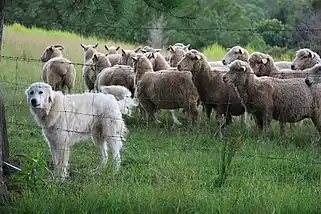
Hidden Dimensions of Conflict
Human wildlife conflict also has a range of 'hidden' dimensions that are not typically considered when the focus is on visible consequences. These can include health impacts, opportunity costs, and transaction costs.[55] Case studies include work on elephants in northeast India, where human-elephant interactions are correlated with increased imbibing of alcohol by crop guardians with resultant enhanced mortality in interactions,[56] and issues related to gender in northern India.[57] In addition, research has shown that the fear caused by the presence of predators can aggravate human-wildlife conflict more than the actual damage produced by encounters.[42]
See also
Sources
![]() This article incorporates text from a free content work. Licensed under CC BY-SA 3.0 IGO License statement/permission on Wikimedia Commons. Text taken from The State of the World’s Forests 2020. Forests, biodiversity and people – In brief, FAO & UNEP, FAO & UNEP.
This article incorporates text from a free content work. Licensed under CC BY-SA 3.0 IGO License statement/permission on Wikimedia Commons. Text taken from The State of the World’s Forests 2020. Forests, biodiversity and people – In brief, FAO & UNEP, FAO & UNEP.
References
- Glionna, John M. (May 27, 2013). "Tourist and animal 'elk jams' worry Grand Canyon park rangers". Los Angeles Times. Retrieved 10 September 2013.
- "Wildlife and protected area management – Human and wildlife conflict". FAO.
- The State of the World’s Forests 2020. Forests, biodiversity and people – In brief. Rome: FAO & UNEP. 2020. ISBN 978-92-5-132707-4.
- IUCN (2020). IUCN SSC Position Statement on the Management of Human-Wildlife Conflict. IUCN Species Survival Commission (SSC) Human-Wildlife Conflict Task Force
- SARPO, WWF. "Human wildlife conflict manual." Harare, Zimbabwe, WWF Southern African Regional Programme Office (SARPO) (2005).
- Madden, Francine (2004). "Creating Coexistence between Humans and Wildlife: Global Perspectives on Local Efforts to Address Human–Wildlife Conflict" (PDF). Human Dimensions of Wildlife. Taylor & Francis Inc. 9 (4): 247–257. doi:10.1080/10871200490505675. ISSN 1087-1209. Retrieved 17 July 2013.
- Cline, R.; Sexton, N.; Stewart, S.C. (2007). A human-dimensions review of human-wildlife disturbance: a literature review of impacts, frameworks, and management solutions(PDF) (Report). U.S. Geological Survey. p. 2. Open-File Report 2007-1111. Archived from the original (PDF) on 16 March 2014. Retrieved 20 July 2013.
- "Human-Wildlife Conflict". Environment Yukon. Government of Yukon. 3 July 2013. Retrieved 20 July 2013.
- IUCN SSC HWCTF (2020) What is human-wildlife conflict? Briefing Paper by the IUCN SSC Human Wildlife Conflict Task Force. www.hwctf.org
- Smilie, Shaun (20 May 2002). "Killer Cats Hunted Human Ancestors". National Geographic News. National Geographic Society. Archived from the original on 16 March 2014. Retrieved 19 July 2013.
- "Taung Child". What does it mean to be human?. Smithsonian Institution. Retrieved 18 July 2013.
- Brochu, Christopher A.; Njau, Jackson; Blumenschine, Robert J.; Densmore, Llewellyn D. (2010). "A New Horned Crocodile from the Plio-Pleistocene Hominid Sites at Olduvai Gorge, Tanzania". PLOS ONE. 5 (2): e9333. doi:10.1371/journal.pone.0009333. PMC 2827537. PMID20195356.
- Myers, N., Mittermeier, R. A., Mittermeier, C. G., Da Fonseca, G. A., & Kent, J. (2000). Biodiversity hotspots for conservation priorities. Nature, 403(6772), 853.
- Manoa, David Owino, and Francis Mwaura. "Predator-Proof Bomas as a Tool in Mitigating Human-Predator Conflict in Loitokitok Sub-County Amboseli Region of Kenya." Natural Resources 7, no. 01 (2016): 28.
- Marker, Laurie L., and Lorraine K. Boast. "Human–wildlife conflict 10 years later: lessons learned and their application to cheetah conservation." Human Dimensions of Wildlife 20, no. 4 (2015): 302-309.
- Muir 1, 2, Matthew J. "Human–predator conflict and livestock depredations: Methodological challenges for wildlife research and policy in Botswana." Journal of International Wildlife Law & Policy 13, no. 4 (2010): 293-310.
- Graham, Maximilian D., Benedikt Notter, William M. Adams, Phyllis C. Lee, and Tobias Nyumba Ochieng. "Patterns of crop-raiding by elephants, Loxodonta africana, in Laikipia, Kenya, and the management of human–elephant conflict." Systematics and Biodiversity 8, no. 4 (2010): 435-445.
- Goodrich, John M. "Human–tiger conflict: a review and call for comprehensive plans." Integrative Zoology 5, no. 4 (2010): 300-312.
- Desai, Ajay A., and Heidi S. Riddle. "Human-elephant conflict in Asia." Supported by: US Fish and Wildlife Service Asian Elephant Support (2015): 10-12.
- Priston, Nancy EC, and Matthew R. McLennan. "Managing humans, managing macaques: Human–macaque conflict in Asia and Africa." In The macaque connection, pp. 225-250. Springer, New York, NY, 2013.
- James Owen (6 August 2003). "Leopard Seal Kills Scientist in Antarctica". nationalgeographic.com. Archived from the original on 27 April 2020. Retrieved 15 July 2020.
- Klenke, R., Irene Ring, Andreas Kranz, Niels Jepsen, Felix Rauschmayer, and Klaus Henle. "Human-Wildlife Conflicts in Europe." FRAP Project, European Union (2011).
- Rigg, Robin, Slavomír Finďo, Maria Wechselberger, Martyn L. Gorman, Claudio Sillero-Zubiri, and David W. Macdonald. "Mitigating carnivore–livestock conflict in Europe: lessons from Slovakia." Oryx 45, no. 2 (2011): 272-280.
- Nyhus, Philip J. "Human–wildlife conflict and coexistence." Annual Review of Environment and Resources 41 (2016): 143-171.
- Treves, Adrian, Randle R. Jurewicz, Lisa Naughton-Treves, Robert A. Rose, Robert C. Willging, and Adrian P. Wydeven. "Wolf depredation on domestic animals in Wisconsin, 1976-2000." Wildlife Society Bulletin (2002): 231-241.
- Vaske, Jerry J., Jennifer M. Roemer, and Jonathan G. Taylor. "Situational and emotional influences on the acceptability of wolf management actions in the Greater Yellowstone Ecosystem." Wildlife Society Bulletin 37, no. 1 (2013): 122-128.
- Poessel, Sharon A., Stewart W. Breck, Tara L. Teel, Stephanie Shwiff, Kevin R. Crooks, and Lisa Angeloni. "Patterns of human–coyote conflicts in the Denver Metropolitan Area." The Journal of Wildlife Management 77, no. 2 (2013): 297-305.
- Crook, Stephen ES. "Attitudes and Risk Perception Toward the Mountain Lion Bordering the Santa Cruz Mountains, California." society & animals 1, no. aop (2019): 1-25.
- Zarco-González, Martha M., Octavio Monroy-Vilchis, Clarita Rodríguez-Soto, and Vicente Urios. "Spatial factors and management associated with livestock predations by Puma concolor in Central Mexico." Human ecology 40, no. 4 (2012): 631-638.
- Lukasik, Victoria M., and Shelley M. Alexander. "Human–coyote interactions in Calgary, Alberta." Human Dimensions of Wildlife 16, no. 2 (2011): 114-127.
- Baxter, Greg, and Nicole Davies. "Movements of dingoes on K’gari-Fraser Island: implications for management." Australasian journal of environmental management 25, no. 1 (2018): 132-146.
- Kross, Sara M., Jason M. Tylianakis, and Ximena J. Nelson. "Effects of introducing threatened falcons into vineyards on abundance of passeriformes and bird damage to grapes." Conservation Biology 26, no. 1 (2012): 142-149.
- Kross, Sara M., Katherine P. Ingram, Rachael F. Long, and Meredith T. Niles. "Farmer perceptions and behaviors related to wildlife and on‐farm conservation actions." Conservation Letters 11, no. 1 (2018): e12364.
- Jones, Darryl N., and Leoni K. Thomas. "Attacks on humans by Australian magpies: management of an extreme suburban human-wildlife conflict." Wildlife Society Bulletin (1973-2006) 27, no. 2 (1999): 473-478.
- Hill, Nichola J., Kelly A. Carbery, and Elizabeth M. Deane. "Human–possum conflict in urban Sydney, Australia: public perceptions and implications for species management." Human dimensions of wildlife 12, no. 2 (2007): 101-113.
- HernÄndez, F., D. Corcoran, G. Graells, C. RÕos, and M. C. Downey. "Rancher perspectives of a livestock-wildlife conflict in Southern Chile." Rangelands 39, no. 2 (2017): 56-63.
- Espinosa, Santiago, and Susan K. Jacobson. "Human-wildlife conflict and environmental education: Evaluating a community program to protect the Andean bear in Ecuador." The Journal of Environmental Education 43, no. 1 (2012): 55-65.
- Draheim, Megan M., Francine Madden, Julie-Beth McCarthy, and Edward CM Parsons, eds. Human-wildlife conflict: complexity in the marine environment. Oxford University Press, USA, 2015.
- Tixier, Paul, Mary-Anne Lea, Mark A. Hindell, Christophe Guinet, Nicolas Gasco, Guy Duhamel, and John PY Arnould. "Killer whale (Orcinus orca) interactions with blue-eye trevalla (Hyperoglyphe antarctica) longline fisheries." PeerJ 6 (2018): e5306.
- Cummings, C. R., M. A. Lea, and J. M. Lyle. "Fur seals and fisheries in Tasmania: an integrated case study of human-wildlife conflict and coexistence." Biological Conservation (2019).
- Guerra, Ana Sofia. "Wolves of the Sea: Managing human-wildlife conflict in an increasingly tense ocean." Marine Policy 99 (2019): 369-373.
- Pooley, Simon, M. Barua, W. Beinart, A. Dickman, G. Holmes, J. Lorimer, A. J. Loveridge et al. "An interdisciplinary review of current and future approaches to improving human–predator relations." Conservation Biology 31, no. 3 (2017): 513-523.
- Pooley, S., Barua, M., Beinart, W., Dickman, A., Holmes, G., Lorimer, J., ... & Sillero‐Zubiri, C. (2017). An interdisciplinary review of current and future approaches to improving human–predator relations. Conservation Biology, 31(3), 513-523.
- Bradley, E. H., Pletscher, D. H., Bangs, E. E., Kunkel, K. E., Smith, D. W., Mack, C. M., ... & Jimenez, M. D. (2005). Evaluating wolf translocation as a nonlethal method to reduce livestock conflicts in the northwestern United States. Conservation Biology, 19(5), 1498-1508.
- Massei, Giovanna, Roger J. Quy, Joanne Gurney, and Dave P. Cowan. "Can translocations be used to mitigate human–wildlife conflicts?." Wildlife Research 37, no. 5 (2010): 428-439.
- Kesch, M. Kristina, Dominik T. Bauer, and Andrew J. Loveridge. "Break on through to the other side: the effectiveness of game fencing to mitigate human—wildlife conflict." African Journal of Wildlife Research 45, no. 1 (2015): 76-88.
- Ngama, Steeve, Lisa Korte, Jérôme Bindelle, Cédric Vermeulen, and John R. Poulsen. "How bees deter elephants: beehive trials with forest elephants (Loxodonta africana cyclotis) in Gabon." PloS one 11, no. 5 (2016): e0155690.
- "WWF-World Wide Fund for Nature". Springer Reference. SpringerReference. Springer-Verlag. 2011. doi:10.1007/springerreference_75919.
- Nyhus, Philip J., Steven A. Osofsky, Paul Ferraro, Francine Madden, and Hank Fischer. "Bearing the costs of human-wildlife conflict: the challenges of compensation schemes." CONSERVATION BIOLOGY SERIES-CAMBRIDGE- 9 (2005): 107.
- Ogra, Monica, and Ruchi Badola. "Compensating human–wildlife conflict in protected area communities: ground-level perspectives from Uttarakhand, India." Human Ecology 36, no. 5 (2008): 717.
- Anthony, Brandon P., Peter Scott, and Alexios Antypas. "Sitting on the fence? Policies and practices in managing human-wildlife conflict in Limpopo Province, South Africa." Conservation and Society 8, no. 3 (2010): 225.
- Miller, Jennifer RB. "Mapping attack hotspots to mitigate human–carnivore conflict: approaches and applications of spatial predation risk modeling." Biodiversity and Conservation 24, no. 12 (2015): 2887-2911.
- Sitati, Noah W., Matthew J. Walpole, Robert J. Smith, and Nigel Leader‐Williams. "Predicting spatial aspects of human–elephant conflict." Journal of Applied Ecology 40, no. 4 (2003): 667-677.
- Moreira-Arce, Darío, Carolina S. Ugarte, Francisco Zorondo-Rodríguez, and Javier A. Simonetti. "Management tools to reduce carnivore-livestock conflicts: current gap and future challenges." Rangeland ecology & management 71, no. 3 (2018): 389-394.
- Barua,M., Bhagwat, S.A. and Jadhav, S. (2013). "The hidden dimensions of human-wildlife conflict: Health impacts, opportunity and transaction costs". Biological Conservation. 157(2013): 309–316. doi:10.1016/j.biocon.2012.07.014
- Barua,M. (2013). "Volatile ecologies: towards a material politics of human-animal relations". Environment and Planning A. 0 (6): 1462–1478. doi:10.1068/a46138. Retrieved 21 December 2013.
- Ogra, M. (2008). "Human-wildlife conflict and gender in protected area borderlands: A case study of costs, perceptions, and vulnerabilities from Uttarakhand (Uttaranchal), India". Geoforum. 39 (May 2008): 1408–1422.
External links
- IUCN SSC Human-Wildlife Conflict Task Force
- Guidelines for the Coexistence between People and Jaguars – illustrated guide for free download (in Portuguese and Spanish
- Review of Human-tiger Conflict Mitigation Measures Practiced in South Asia
- Guidelines for human-leopard conflict management.
- A collaborative effort to solve the Human Elephant Conflict (HEC) in Sri Lanka.
- Little Blue Society: Human-Animal Conflict Resolution - cutting-edge behavioral strategies to permanently resolve human-animal conflicts over geographical areas and resources http://www.littlebluesociety.org